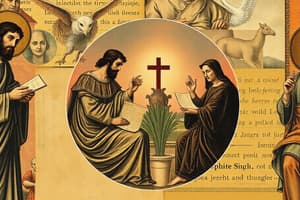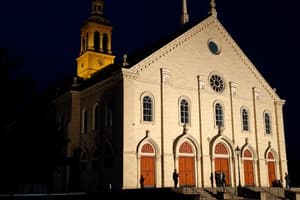Podcast
Questions and Answers
What is the significance of Jesus in the Byzantine Empire and medieval Europe?
What is the significance of Jesus in the Byzantine Empire and medieval Europe?
Jesus' life and teachings formed the foundation of the Christian faith, which became the dominant religion of both the Byzantine Empire and medieval Europe. His influence led to the rise of Christian institutions, shaping laws, culture, and governance in both regions.
What is the significance of Apostle Paul's role in spreading Christianity?
What is the significance of Apostle Paul's role in spreading Christianity?
Paul played a crucial role in spreading Christianity beyond Jewish communities, making it a global faith. His letters (Epistles) laid the theological groundwork for Christian doctrine, influencing both Byzantine and Western European religious traditions.
What is the significance of the Petrine Doctrine?
What is the significance of the Petrine Doctrine?
The Petrine Doctrine, which claimed that the Pope inherited Peter's authority, strengthened the Papacy's power and contributed to the division between the Roman Catholic and Eastern Orthodox Churches.
What is the significance of Constantine legalizing Christianity?
What is the significance of Constantine legalizing Christianity?
What is the significance of Monasticism in Byzantine and medieval Europe?
What is the significance of Monasticism in Byzantine and medieval Europe?
What is the significance of the Carolingian Dynasty?
What is the significance of the Carolingian Dynasty?
What is the significance of Clovis I in unifying the Franks?
What is the significance of Clovis I in unifying the Franks?
What is the significance of Charles Martel in the Battle of Tours?
What is the significance of Charles Martel in the Battle of Tours?
What is the significance of Charlemagne's reign in expanding the Frankish Empire and initiating the Carolingian Renaissance?
What is the significance of Charlemagne's reign in expanding the Frankish Empire and initiating the Carolingian Renaissance?
What is the significance of the Pope in medieval Europe?
What is the significance of the Pope in medieval Europe?
What is the significance of the Schism of 1054?
What is the significance of the Schism of 1054?
What is the significance of Theodosius' reign in the Roman Empire?
What is the significance of Theodosius' reign in the Roman Empire?
What is the significance of Diocletian's reforms in the Roman Empire?
What is the significance of Diocletian's reforms in the Roman Empire?
What is the significance of the Edict of Milan?
What is the significance of the Edict of Milan?
What is the significance of the Patriarch in the Eastern Orthodox Church?
What is the significance of the Patriarch in the Eastern Orthodox Church?
What is the significance of the Bishop in the Christian Church?
What is the significance of the Bishop in the Christian Church?
What is the significance of Rome in the history of the Western Roman Empire and the Papacy?
What is the significance of Rome in the history of the Western Roman Empire and the Papacy?
What is the significance of Aachen in Charlemagne's empire?
What is the significance of Aachen in Charlemagne's empire?
What is the significance of Constantinople in Byzantine history?
What is the significance of Constantinople in Byzantine history?
What is the significance of Icons in Christian worship?
What is the significance of Icons in Christian worship?
What is the significance of the Franks in the history of Europe after the fall of the Roman Empire?
What is the significance of the Franks in the history of Europe after the fall of the Roman Empire?
What does the reign of Clovis I, Charles Martel, and Charlemagne reveal about the nature of medieval kingship in the West?
What does the reign of Clovis I, Charles Martel, and Charlemagne reveal about the nature of medieval kingship in the West?
Explain why a powerful Byzantine Empire developed?
Explain why a powerful Byzantine Empire developed?
What are the causes of the schism of 1054?
What are the causes of the schism of 1054?
What are the key differences between the Roman Catholic Church and the Eastern Orthodox Church?
What are the key differences between the Roman Catholic Church and the Eastern Orthodox Church?
What are some of the main arguments for the fall of the Western Roman Empire?
What are some of the main arguments for the fall of the Western Roman Empire?
What role did the Christian Church play in the aftermath of the fall of the Western Roman Empire?
What role did the Christian Church play in the aftermath of the fall of the Western Roman Empire?
Flashcards
Jesus
Jesus
Central figure of Christianity; his teachings shaped Christianity's foundation.
Apostle Peter
Apostle Peter
Traditionally the first Pope, a leader of early Christianity, linked to the Petrine Doctrine.
Apostle Paul
Apostle Paul
Crucial in spreading Christianity beyond Jewish communities; wrote influential letters.
Constantine
Constantine
Signup and view all the flashcards
Monasticism
Monasticism
Signup and view all the flashcards
Battle of Tours
Battle of Tours
Signup and view all the flashcards
Carolingian Dynasty
Carolingian Dynasty
Signup and view all the flashcards
Frankish Kingdom
Frankish Kingdom
Signup and view all the flashcards
Carolingian Renaissance
Carolingian Renaissance
Signup and view all the flashcards
Pope
Pope
Signup and view all the flashcards
Petrine Doctrine
Petrine Doctrine
Signup and view all the flashcards
Justinian
Justinian
Signup and view all the flashcards
Edict of Milan
Edict of Milan
Signup and view all the flashcards
Patriarch
Patriarch
Signup and view all the flashcards
Theodosius
Theodosius
Signup and view all the flashcards
Diocletian
Diocletian
Signup and view all the flashcards
Icons
Icons
Signup and view all the flashcards
Schism of 1054
Schism of 1054
Signup and view all the flashcards
Clovis I
Clovis I
Signup and view all the flashcards
Charles Martel
Charles Martel
Signup and view all the flashcards
Charlemagne
Charlemagne
Signup and view all the flashcards
Roman Empire's fall
Roman Empire's fall
Signup and view all the flashcards
Christian Church post-Rome
Christian Church post-Rome
Signup and view all the flashcards
Church Hierarchy
Church Hierarchy
Signup and view all the flashcards
The Petrine Authority
The Petrine Authority
Signup and view all the flashcards
Byzantine power factors
Byzantine power factors
Signup and view all the flashcards
Eastern Orthodox vs. Roman Catholic
Eastern Orthodox vs. Roman Catholic
Signup and view all the flashcards
Aachen
Aachen
Signup and view all the flashcards
Bishop
Bishop
Signup and view all the flashcards
Tetrarchy
Tetrarchy
Signup and view all the flashcards
Study Notes
Assessment Format
- 10 multiple choice questions (2 points each)
- 5 Key Term Identifications (5 points each)
- 2 Short Answer/Primary Source Analysis Questions (15 points each)
Key Terms
- Jesus: Central figure of Christianity, his life and teachings formed the foundation of the Christian faith. His influence shaped laws, culture, and governance in both the Byzantine Empire and medieval Europe.
- Apostle Paul: Crucial in spreading Christianity beyond Jewish communities, making it a global faith. His letters (Epistles) were foundational for Christian theology.
- Apostle Peter: Traditionally considered the first Pope, leader of the early Christian Church. The Petrine Doctrine claimed the Pope inherited Peter's authority, strengthening the Papacy's power.
- Constantine: Legalized Christianity (Edict of Milan, 313 CE), establishing Constantinople as a center of Christianity. Shaped Byzantine religious policies and inspired European rulers.
- Monasticism: Monasteries preserved ancient texts, spread Christianity, and provided education in Byzantine and medieval Europe.
Studying That Suits You
Use AI to generate personalized quizzes and flashcards to suit your learning preferences.




